Resurrection isn’t just the basis for several long-running religions, it can also make for a game-changing plot point in fiction. After all, death is quite a hard reboot, and sometimes killing a character is exactly the shot in the arm a story needs – especially if it’s a fantasy epic, or a comics series that’s been going on a while. But then there’s the next problem—can you get even more of a jolt by bringing the character back? Will their death mean more if they have to contend with life again? If their grand sacrifice becomes a stand-in for a more explicitly religious event?
Since Easter is just around the corner, we’ve gathered some of our favorite takes on resurrection, and ranked them according to, um, data? Actually we just ranked them according to which ones we thought served their narratives best. Let us know if we missed any of your favorites in the comments!
(Potential spoilers ahead for A Song of Ice and Fire/Game of Thrones, The Lord of the Rings, Star Trek, and other SFF properties)
15. Jon Snow, Game of Thrones
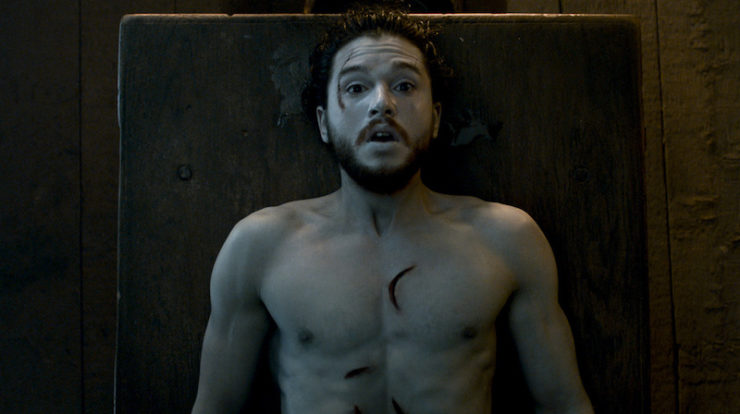
Jon Snow’s resurrection hasn’t happened (yet) in the books, so its occurrence in Game of Thrones was our first real indicator that the show was vaulting confidently past the books, unafraid to alter key elements of the series. In this respect, Jon Snow’s resurrection was awesome, especially since the TV show skipped over A Song of Ice and Fire’s other major undead character: Lady Stoneheart.
But in another sense, this resurrection is annoyingly anti-climactic. Jon dies because he makes the same mistake that Ned did, assuming loyalty and a strong sense of morality where there was none. The mutinous ambush drains any possible tension from that mistake, and his death at the end of season five unravels or nullifies too much of the plot to be convincingly permanent—especially since the red priestess just happened to return to Castle Black at about the same time. The end result for the audience is impatience, and it’s not much of a shock when Jon finally returns to life in season six.
14. Church Creed, Pet Sematary
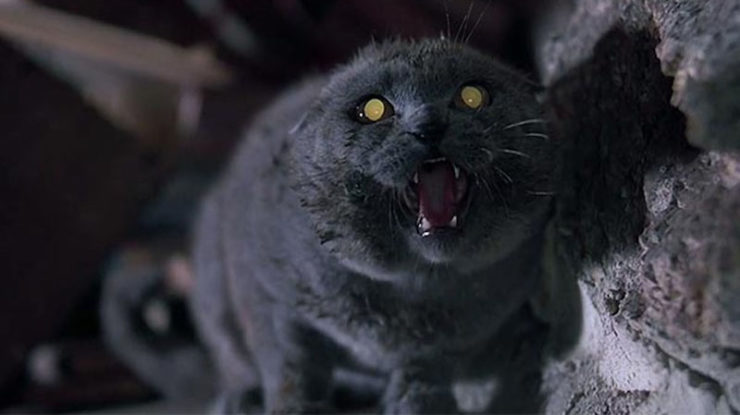
Church is the Creed family cat. He’s on the bottom of this list because, while it’s impressive that he comes back from the dead (after burial in an ancient magical MicMac burial ground, about which the less said the better), he’s not really too cuddly anymore, preferring to rend mice and birds and scatter bits of their corpses around the house. Dying and coming back seems to have really annoyed him, and maybe turned him eeee-villl. Also he smells bad.
And I’m not even going to talk about what happens to the Creed’s baby son, Gage.
13. C.H.O.M.P.S., C.H.O.M.P.S.
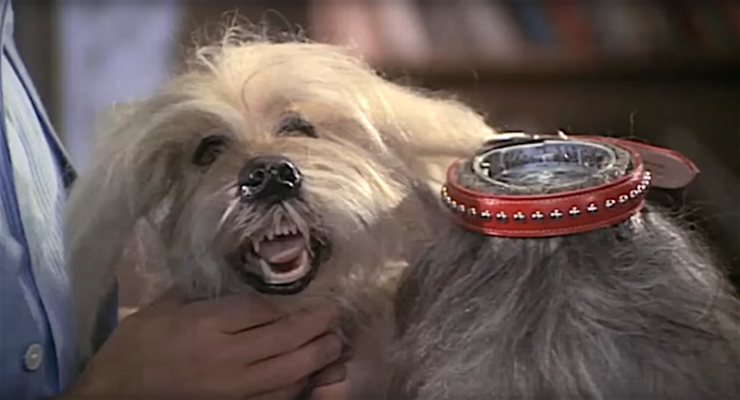
C.H.O.M.P.S. is a late-70s action comedy about a guy who wants to woo a young Valerie Bertinelli, so he… builds a robotic watchdog… to impress her dad… who runs a security company? It’s hard to explain. The film is basically a bunch of labored scenes of the robot dog chasing people while one of his pre-programmed sounds (barking, train whistles, machine gun fire) frightens his victims. Meanwhile, rival security agency-head Jim Backus schemes to steal him away for his own uses. At some point, for some inexplicable reason, C.H.O.M.P.S. is sent to sniff out a bomb. It blows him up, and since he looks like a real dog, everyone is sad and traumatized. But after a few minutes of everyone thinking he’s been damaged beyond repair, his eyes begin to glow, and suddenly he’s alive again, implying that C.H.O.M.P.S. has some sort of consciousness beyond his programming, or a soul, or something? It’s very confusing.
Honestly C.H.O.M.P.S. on this list because I wanted to make sure this movie wasn’t just a dream I had once.
12. Gurgi, The Black Cauldron (Film)
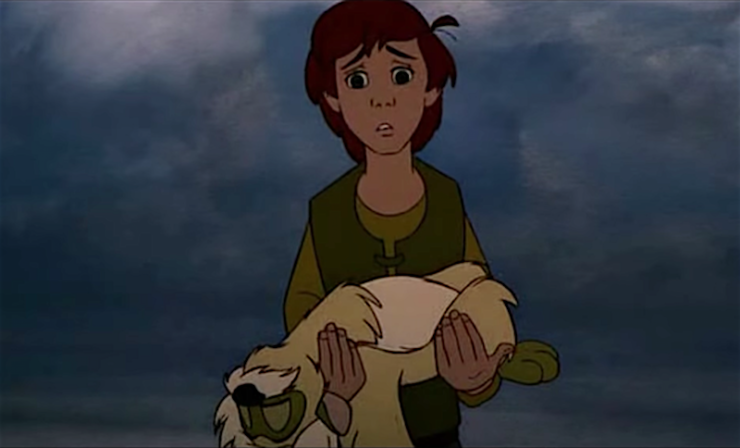
Gurgi doesn’t die in the book. A different character (name redacted for non-spoiler purposes) is the one who leapt into the Black Cauldron—and they stay leaped. But in the movie the sacrifice is handed over to the ridiculous apple crunching and munching comic relief character for maximum Disney pathos. He saves our protagonists and leaps into the Cauldron with the ultimate sign off: “Master has many friends. Gurgi has no friends.” That might have been OK, but clearly the execs decided that they didn’t want to kill him, because when he comes back to life (for no discernible reason) the film stock changes color, which has always made me assume that the post-resurrection scenes were just tacked on after a test screening. There’s no emotional pay-off here because Gurgi is so irritating that you kind of wish he’d stayed dead, and then he forces Taran and Eilonwy to kiss in a moment that’s clearly supposed to be cute and Lady and the Tramp-esque, but just seems smarmy.
11. Superman, Various

Maybe DC Comics should kill Superman again? The first time was thrilling in that you could argue it was the first truly widescreen breakthrough moment that comic books had within mainstream pop culture. But that’s ALL it was; a gimmick to energize sales of the title. It said little about the character itself, his legacy, or the vacuum left in his absence. The Superman comics themselves resurrected him only 6 months later.
And we were happy to have him back, of course. Supes shouldn’t go down to some punk called Doomsday. But maybe next time Superman dies and is resurrected…lean into it? Less “emerges from goop inside a giant car engine” (this actually happens) and more “he’s a secular representation of Christ dying for our sins and is revived because we as people are worthy after all”? You don’t really have to go down the Christian mythology rabbit hole with Superman, but how humanity changes him and vice versa is an interesting character story that a death/resurrection tale could really bring into focus.
10. Aslan, The Lion, The Witch, and The Wardrobe

When you’re a kid and you read The Lion The Witch and the Wardrobe Aslan coming back seems, well, miraculous. But then you go back to the story when you’re older and the lightbulb goes off and you see why that particular miracle was inevitable. Realizing that Aslan has been Jesus all along it kind of makes the whole coming-back-from-death-thing seem inevitable? It robs it of some of its power.
BUT. Having said that, there’s no denying how powerful it is that the truly dead and bloody and broken lion gets up off the sacrificial rock, shakes death off, and reassures Mary Magdalene and the other Mary Susan and Lucy that he’s really alive now, and everything’s cool.
9. Alex Murphy, RoboCop
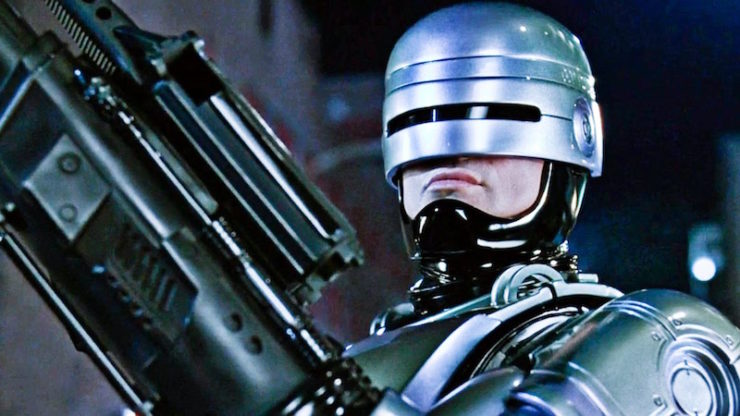
Much like Aslan, the resurrection in RoboCop is really just a thin veneer of genre storytelling over a much older story. (I’m speaking, of course, of Tammuzi, consort of Ishtar). RoboCop ranks slightly higher—first, because the grittier story lends itself to some great social commentary, but more importantly, because the audience truly experiences the death and resurrection of Alex Murphy. We’re in Alex’s POV as he’s murdered and humiliated, and we’re back in his POV when he’s rebooted in his rad new robo-body. And then, we get to experience the real difficulties of resurrection: the part where you have to embark on a new life, continually pestered by horrifying memories of your own murder.
I’ll buy that for a dollar.
8. Sara Lance, Arrow/Legends of Tomorrow
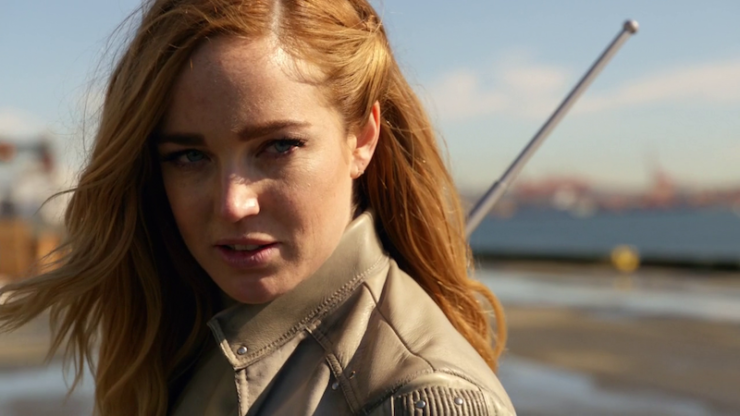
The thing that makes Sara Lance’s resurrection great isn’t the actual resurrection, a sequence featuring Ra’s al Ghul’s very special hot tub (yeah, yeah, it’s called the Lazarus Pit). Nor is it the part after her resurrection, when Sara, missing her soul, goes feral. (This fate awaits Thea Queen, too, eventually, because Arrow has never met a trope it didn’t want to poke at from several angles.) Sure, that gives Oliver a chance to call his old buddy John Constantine, but even Constantine can’t hold a candle to the real bright spot here: the further development of Sara Lance herself. First she was just Laurel’s sister, the girl Ollie secretly took on that fated boat trip; then she was a member of the League of Assassins, a second-string Arrow character whose every appearance was a highlight. But brought back from the dead, she got to evolve into something even better: the smirking, flawed, badass, bisexual captain of the misfit gang of half-broken toys that make up the Legends of Tomorrow. After a shaky first season, Legends embraced its goofiness and doubled down on everyone’s best traits: Ray Palmer’s earnest sensitivity, Mick Rory’s weirdly endearing grumbles, Leonard Snart’s drawling delivery (RIP, Snart-of-Earth-1), and Sara’s reluctant-yet-effective captaincy. She had to come back from the dead—and embrace that death, and wear a lot of goofy outfits—to wind up in this position, and damn, she’s earned it.
7. Ian Malcolm, Jurassic Park and The Lost World

This one’s a reverse Gurgi! Ian Malcolm totally dies in the book. He’s lying there at the Isla Nublar Visitor Center, a big dinosaur bite taken out of him, whacked out of his math-loving gourd on morphine, babbling about paradigm shifts, and he dies.
He is dead, dead, deadski. Everyone is very clear on this.
But then! Steven Spielberg made a film of Jurassic Park, and it was an enormous hit, and Jeff Goldblum Jeff Goldblumed all over the character (becoming a certain generation’s Labyrinth-era David Bowie along the way) and lo! When Michael Crichton came to write The Lost World, suddenly Ian Malcolm was totally fiiiine. All the other characters just thought he was dead, but luckily some other people found him (???) and brought him back to life (????) so the breakout star of the film of the first book could be the star of the second book, and its (underrated, IMO) film adaptation.
“Crichton creates Malcolm, Crichton kills Malcolm. Goldblum kills as Malcolm, Crichton creates Malcolm again.”
6. Gandalf, The Lord of the Rings
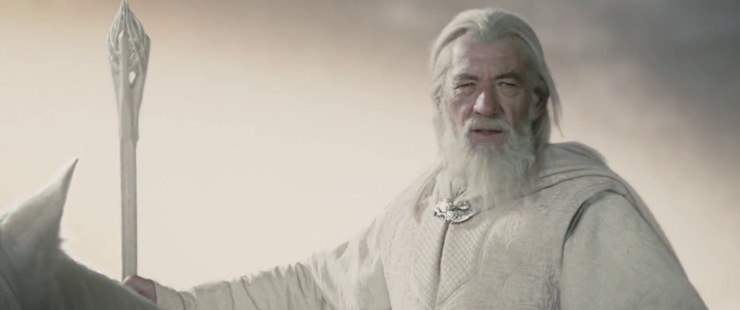
Yes, I know, you think he should be higher. While his return is awesome and inspirational, the Fellowship might have been better off if he’d just stayed alive in the first place, rather than being too arrogant in his dealings with the Balrog. Most of all though, he’s kind of a dick when he comes back? He’s snarky and aloof, and then halfway through the Return of the King he finally reveals that there’s totally an afterlife, but he only tells Pippin, right before a giant battle that none of them expect to survive, but doesn’t bother to tell any of the countless barely-trained citizens going into battle—just Pippin.
Dick move, Gandalf.
5. Morpheus, The Sandman
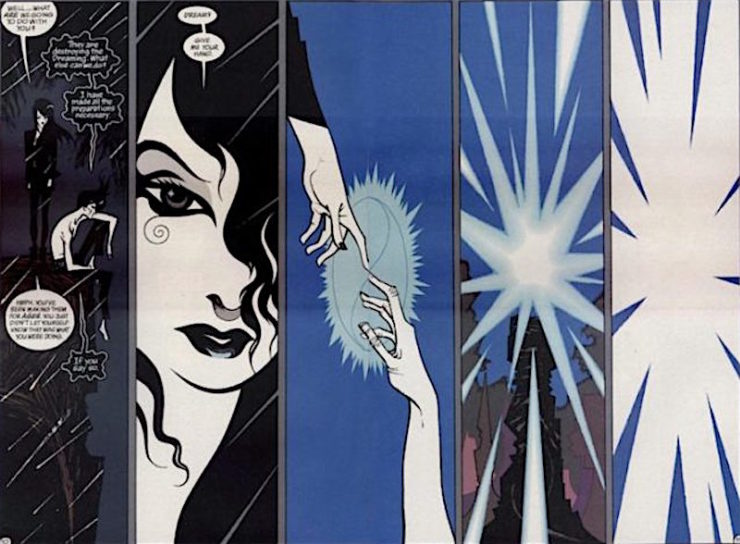
Morpheus’s sacrifice is a fascinating one, because he isn’t really dying for a person, but for a concept. He realizes that he can’t change fast enough to remain a relevant Lord of All Dreaming; he’s too austere, too hung up on rules. Plus, after eons of service, he’s simply tired. So he allows the Kindly Ones to pursue him, he gives up fighting them, and then he calls upon his big sister. Even after the issues and issues of buildup, Morpheus’ death is shocking; personally it may be the first time I encountered a work of fiction where the old writing advice of “make your ending both inevitable and surprising” idea clicked into place: of course Morpheus has to die, but of course I didn’t expect him to go through with it. The death is real, the Endless mourn, they hold a wake, and all of humanity is shaken knowing that there’s been a disturbance in the natural order.
And then sweet, lovely Daniel appears to take on his new role, and life rolls on.
4. Buffy, Buffy the Vampire Slayer
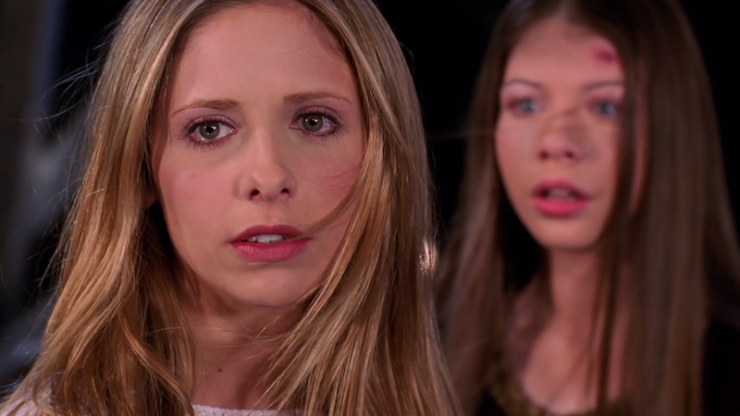
Buffy saved the world a lot, and she also died multiple times. In season one’s “Prophecy Girl,” the show pulls the rug out from under us when the Master successfully drown her and leaves her dead. It’s a harsh, terrifying moment in a show that wasn’t exactly a lighthearted romp. But then Xander and Angel find her soon enough, and Xander’s able to CPR her back to life. But that’s only a practice death. The Real Thing comes in season five’s “The Gift.” Buffy chooses to leap into an inter-dimensional Hell portal, knowing that only the blood of a Summers girl will close it—and knowing that if she doesn’t jump, her sister Dawn is doomed. The rest of the Scoobies assume that she’s trapped in a Hell dimension, and spend months working on a spell to bring her back to life. Unfortunately, when she does come back, it turns out she’s been in Heaven the whole time, and not even life in California quite measure up to that.
Buffy gets extra points here for: choosing to take her sister’s place, dealing with the genuine existential crisis that comes after death and resurrection, working through that crisis in some remarkably censor-baiting scenes with Spike, and ultimately choosing to be alive at the end of about two seasons of mourning for herself.
We’ve got a two-way tie for second place here:
3. The Doctor, Doctor Who
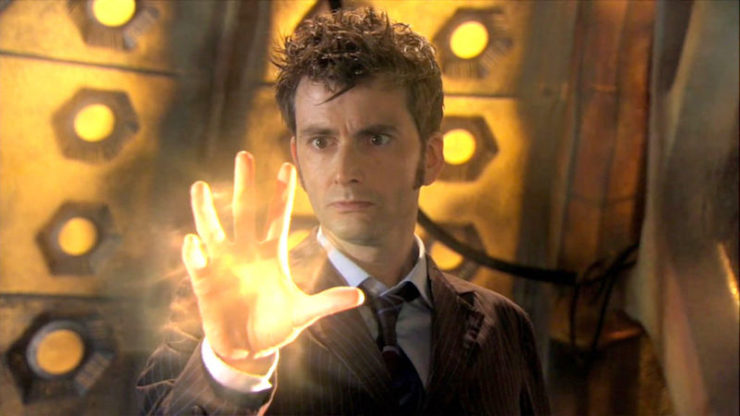
The best thing about the Doctor’s resurrection is that death always means a brand new chance at life. The viewer isn’t supposed to worry much over the Doctor leaving us because the Doctor is never really gone—just revived and renewed and reclaimed by another face. And while it’s always jarring to be faced with that brand new person, it’s also like getting a chance to fall in love again; we are reminded of why we love the character so much, and get to appreciate them anew by seeing another actor put their spin on the part.
But regenerations are always fraught with emotion because the Doctor doesn’t live like a normal Time Lord—often these changes are the result of doing something terribly heroic, and then there’s a dramatic speech and sometimes there are companions standing around crying, and the whole thing is very hard to sit quietly through. The point is, all Doctor Who fans are secretly sadists, because it’s just cruel to do this to yourself every few years.
2. Spock, Star Trek III: The Search for Spock
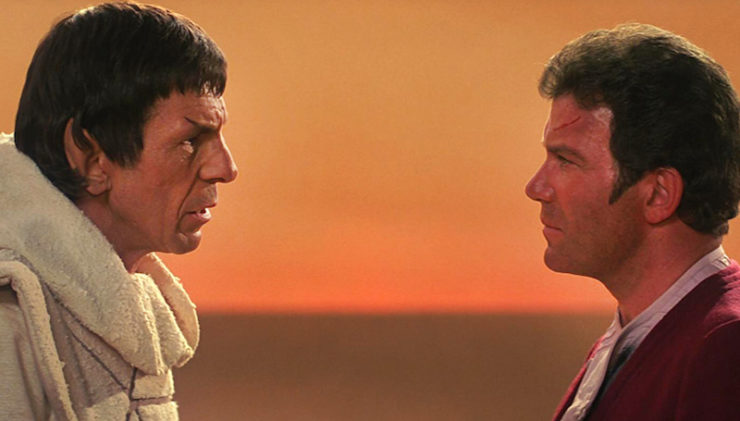
Spock’s death is one of the most affecting in science fiction’s history, and literally no one is allowed to refute this because it is scientifically proved and impossible to renounce. There. It is declared. There are graphs and charts and academic papers backing this up. Spock and Kirk separated by a radiation chamber and having their last conversation is traumatizing, and no one is ever over it, so accept this and do not try to pretend that you’re over it. You don’t have to be over it. You are (ostensibly, if you are reading this) only human.
That being said, if Spock hadn’t been returned to his friends in the next film, this tragedy would have become unbearable. Whatever your feelings on Star Trek III, its endgame cannot be denied because when all is said and done, Spock is standing there in desperate need of a haircut, and he’s fairly sure that he knows this guy in front of him because “…Jim. Your name is Jim.”
*muffled sobs issue from the corner*
1. Iron Giant, The Iron Giant
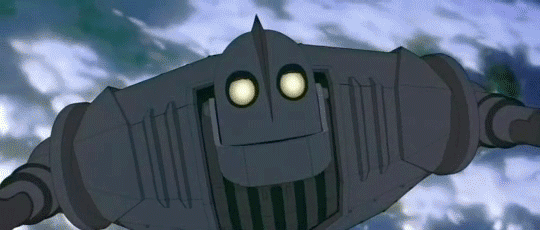
The Iron Giant goes out sacrificing himself for Hogarth and the rest of humanity. This moment is one of the most heartrending scenes in all of children’s film. But after a warm ending sequence where we learn that Hogarth has finally made some friends, and his mom and Dean have fallen in love, we check back in with one of the Giant’s rivets as it rolls through forests, down a beach and into the sea. We sweep up over the ocean and into the Arctic, where we see the Giant’s antenna sending out a homing beacon for all of his scattered parts. It may take a while, but Superman is going to return.
Ugh I’m crying AGAIN FFS
[Clears throat, blows nose.] Anyway, what are your favorite SFF resurrections? Tell us all about them in the comments!










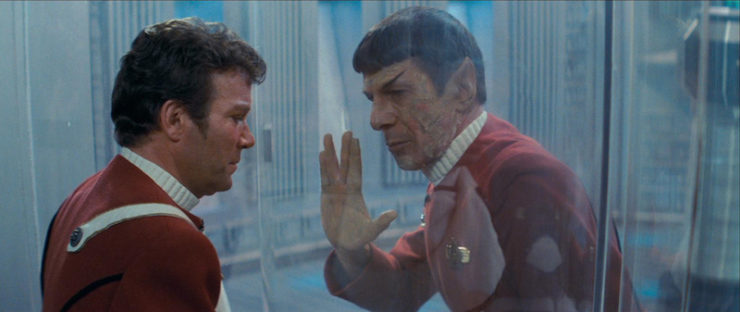
Even though technically Gandalf died, being a long time RPG’er I saw it more as “leveling up.” :)
Does dieing and coming back as something or someone else count? If so there are lots more you could add to the list.
Oh sure, don’t mention Glorfindel, the other Balrog-based death-and-return. But I’ll just go ahead and assume it’s only because there’s no movie still to grab for him. :)
And allow me to nominate one other I’m sure you guys accidentally forgot.
John Sheridan, Babylon 5, if for no other reason than his response upon being asked if had truly been dead: “I was. I’m better now.”
Not only was Gandolf a dick when he came back, he was also a crappy wizard the whole time.
“Hey, we need to light the watchfires of Gondor to signal the war is on. Yo, Pippin, I need to you to risk life and limb to climb up and set it on fire. Don’t get caught.”
“Umm, Gandolf, why don’t you just drop a magic missile or fireball up there and light them yourself?”
“. . . .”
Count the number of times he did actual wizarding in the trilogy. He throws less than half a dozen spells and only two times is it actually useful. Guy is piking big time while the melees die.
@5
As wizards go his use of magic seems fairly lame. He is good at turning his staff into a light source :)
I’m going to suggest Misery Chastain, the heroine of the book within the book whose death is the whole catalyst for the plot of Stephen King’s Misery.
The death of the Iron Giant is so perfect that your GIF nearly had me in tears. But his resurrection is the worst. 1) It strains plausibility too far to have his repair circuits able to overcome vaporization in the center of a nuclear explosion. 2) Just because the Giant has enough free will to choose to die doesn’t negate the real risk that he may be, to some extent, a prisoner of his own programming who can be pushed into violent action that he didn’t exactly intend. Having his physical body continue both makes this challenging point less interesting by implying that he can have a once-for-all victory over his own programming and badly undercuts the foreshadowing of his earlier line “Souls don’t die”.
My 2 cents. I need to stop crying and work.
I was thinking of Big Hero 6.
@6,
Adding light to a staff isn’t even a 1st level mage spell. Its a 0 level cantrip. Gandalf is possibly the worst wizard in history, worse even than Rincewind.
@10
Well you have to give him some credit. He was good at getting moths, Eagles and Hobbits to do his bidding. Plus he did manage to kill a Balrog, no small feat. But yea his use of magic was fairly weak.
Slightly baffled that there doesn’t seem to be a single poster on this thread who has read The Lord of the Rings as opposed to watching the Peter Jackson movies. Literally none of these criticisms of Gandalf are relevant to the character Tolkien wrote. Huh.
Xena and Gabrielle come to mind as one of my more favorite resurrections.
Well there is one character who has died so often that there is a wiki page dedicated to solely to their deaths and rebirths.
http://tfwiki.net/wiki/The_many_deaths_of_Optimus_Prime
Some of them didn’t even stick for the entire episode, and some of the comic ones lasted less than a whole page.
Then there is the infamous:
@@@@@#12: Yeah, I was thinking the same thing.
Although even if you limit yourself to the crap in the movies, there’s still the atomic leaf-blower duel with Saruman.
Sam from “Lord of Light”
Daniel Jackson, Stargate SG-1. And not only does he die, ascend, and return to human form, he does it TWICE. The first time is more emotional, but the second one is hilarious because he shows up naked in Jack’s office and has to drape himself with the flag.
And agree with @12. The comments in the article about Gandalf are just bizarre. Is only his screen character being evaluated? Because that doesn’t make sense. Not sure how you can know about Aslan being Jesus and not Gandalf, but Gandalf’s resurrection is Christ-like, and his reappearance to Aragorn, Gimli, and Legolas in TT is like the transfiguration. His power is fire because that corresponds with the Holy Spirit. (I realize a lot of people read Tolkien and don’t see these things, which is part of his brilliance: he was a great storyteller, and his stories can be read on multiple levels. You can also see the influence of World War II, for example.)
@17, pretty sure Tolkien was writing about WW1, the war he actually fought in. Not saying WW2 wasn’t an influence, just that it wasn’t the war he watched friends die in front of him.
Harry Dresden pulled a nifty die/haunt/return.
Harry Potter probably deserves a mention, since his death/return was both suuuuuuuuuuuuuper foreshadowed, suuuuuuuuuuuuuper obvious, and yet still totally emotional because of the great lead up to it.
My favorite resurrection(s) in ASOIAF are those of Beric Dondarrion, because I get to call him Ser Diesalot. I don’t count Aeron Greyjoy because he didn’t actually die, even if he saw Heaven (sorry, dear).
I would rate Gandalf’s resurrection more highly because his retelling of it is so lyrically beautiful and mysterious. The film can’t do that retelling justice, but portrayed a visual synopsis fairly well, methinks. (I would also rate it more highly because I haven’t read/watched most of the others on this list)
In the 1982 John Milius-Oliver Stone Conan the Barbarian, the warrior woman, Valeria (Sandahl Bergman), promises Conan (Arnold Schwarzenegger) that, even if she were killed, she would come back from Hell itself to save him if he needed her. She is killed, but when Conan needs her, she keeps her promise.
@19 – Harry was only MOSTLY dead ;)
Great theme for an article! Many of these really pull at the heartstrings. Another great one is Leia, in The Last Jedi. Stunning scene.
I think I’d have to add Lindsey Brigman from The Abyss.
If “replaced by your own clone with your own upoaded memories” counts, there’s Georgia Mason in Mira Grant’s “Newsflesh” series.
If “cryorevival” counts, there’s Miles Vorkosigan’s little case of death by needle grenade and subsequent resurrection, in Bujold’s Brothers In Arms.
If “you can only really kill a werewolf with a silver bullet” counts, let’s not forget Pratchett’s Angua.
If “death is not necessarily a permanent condition with the right sorcerer nearby” counts, there’s the reciprocal assassinations of Vlad Taltos and Cawti.
If “is really a solar deity; when killed, revives with the dawn” counts, there’s “Shiny” aka Bright Itempas, in N. K. Jemisin’s The Broken Kingdoms.
@26:
If “replaced by your experimental predecessor with your own uploaded memories, including Irving Berlin showtunes,” there’s Data in Star Trek: Nemesis.
It seems kinda disingenuous to talk about the Death of Superman without referencing the long-lasting fallout of his return; the introduction of two new characters (Steel & Superboy), the return of a couple of old one-hit-wonders (Hank Henshaw & the Eradicator), years’ worth of Green Lantern mythology (the destruction of Coast City led to Hal Jordan becoming Parallax, which led to Emerald Twilight, which led to Kyle Rainer, which led to Zero Hour, which led to Final Night, which led to Jordan becoming the Spectre. . .).
Of course, a personal favourite is Naraku’s death and resurrection in InuYasha: The Castle Beyond the Looking Glass. The master manipulator dies (for real, as confirmed by magic) in a complicated plot involving a sleeper horcrux, a traitorous subordinate, a rival in hiding, and knowing exactly what all of his enemies would do, leading inevitably to his resurrection, having become even more powerful after killing said rival and absorbing her power. He played everyone like pawns without even needing to be alive for it.
It’s easy nowadays; you can finish watching The Wrath of Khan and then pop the disc for The Search for Spock into the player (or cue it up on your streaming service), and he’ll be alive again in a couple of hours. But back in 1982, Spock was dead for two long years, which was a long time to be heartbroken for.
I haven’t been able to watch TWOK since Leonard Nimoy died; what I watched the day he died was TSFS.
Duncan Idaho, first reborn as Hayt the ghola, then resurrected multiple times by Leto the God Emperor.
Naussica from Valley of the Wind.
And of course the entire cast of Dragon Ball Z, including all of planet Earth.
In A.E. van Vogt’s trippy classic, The World of Null-A (1945, 1948) the hero, Gilbert Gosseyn, first discovers that his memories are fake and then, after he is killed but shows up again, begins to suspect something really funny is going on.
With van Vogt you sometimes get the feeling he actually had a line to the future, but just garbled the information , putting it down.
How about Phil Coulson? Since he got back from Tahiti, he just hasn’t been the same…
Kinda surprised WoT hasn’t got a mention yet! I’ve whited out for spoilerishness as Kelsey’s doing a brilliant ‘read‘ of it at the moment. Seriously, so much praise!
// Rand’s death is foreshadowed really well. With Min’s viewing in tEotW and then several more times during the series, by the time we get to aMoL most of us knew he was probably going to die. The confidence he shows all the way up to the end is enough to convince many of the other characters though, so it’s heartbreaking when it actually happens. His rebirth, by comparison, was completely unexpected, so even when it’s being teased, you never really believe it until it happens. Well, I didn’t, even up to the point of confirmation, I wasn’t sure there wasn’t going to be a twist. //
Rachelle @3, YES! SO YES!
If you’re going to do a Tolkien reference, there is no other choice than Beren. To get her boyfriend out of the underworld, Luthien managed to outdo Orpheus from Greek myth.
Given just how good Usagi got at the whole resurrection thing through sheer practice, I think a Sailor Moon reference should have been included in the list.
@@.-@: +1 for John Sheridan.
@23: A comment that of course raises the question of why is Wesley not a part of this discussion? Maybe Miracle Max edited this article (“I’m not listening! I’m not listening!”) ;-)
We could also add a whole bunch of Cylons . . .
Just remembered. Does Groot count?
@@@@@ 37 Apparently not. The current groot is said to be an offspring not a resurrection.
One of my favorites is from the “VOR, The Maelstorm” game books. Particularly “The Playback War”, where the protagonist dies at the end of each chapter only to be brought back a little earlier in time to try again at the beginning of the next chapter. I’m pretty sure that Tom Cruse’s move “Edge of Tomorrow” was inspired by this book.
@39/Wayne: Edge of Tomorrow, starring Tom Cruise and Emily Blunt, is based on Japanese SF writer Hiroshi Sakurazaka‘s 2014 novel, All You Need Is Kill.
A time-looping story like this, of course, in a sense resurrects everyone who died during the time period covered by the loop, at least tens of thousands in this particular case, if I remember correctly.
Mat? Aviendha? Their death by Rahvin was undone by Rand’s use of balefire. Very emotional at the time but the full ramifications aren’t really seen until the LAST book when Olver blows the horn as Mat’s link has been cut..
It’s been too long since I read the Malazan series to remember them all, but I know there’s more than a few. To the point where a character says something like “Doesn’t anybody ever stay dead around here?”
Love the Duncan Idaho example, how did I forget about that??
@26 – minor correction: Miles dies and is reborn in Mirror Dance rather than Brothers in Arms.
@several – lots of incidents in this theme in both Wheel of Time and the Taltos books.
One more modern example is the Brust-White Incrementalist books. The entire series is about death of the principals and then their resurrection in new bodies.
If we’re counting the clone thing, then Ariane Emory from C.J. Cherryh’s Cyteen is a really interesting example …
I am assuming the Gandalf references are just tongue in cheek, because he is awesome (in the words of the Toast, so metal he comes back to life a different fucking color). But, fwiw, Tolkien had personally stated Gandalf was NOT intended to be a Christ analogy in any way. That was a little too on the nose for him.
This isn’t really a ‘resurrection’, because she didn’t actually die, but I definitely let out a YAAAAAAAAAAAASSSSSSSSS when Jasnah showed up at the end of Worlds of Radiance. Sanderson does have a few other good ones (although he admits he’s trying not to overuse the trope), especially in the Mistborn books, that I really enjoy.
I have to admit though, in general I prefer the dead to stay dead because it seems too emotionally manipulative otherwise (or too much of a cop out for the writer). But there are some cases it does work out really well plot wise or thematically.
I’m sincerely baffled by the lack of Harry Potter mention, here. The entire story leading up to his death makes it inevitable, and then it was still shocking and upsetting when it happened.
Another mention that’s needed here is Shadow Moon from American Gods by Neil Gaiman. His journey through death is some of the best writing I’ve ever read.
Also, as some others pointed out, book Gandalf and movie Gandalf were pretty different.
How about … the entire population of Earth in the Riverworld series?
I was a fan of the Nameless Necromancer, if only for what his least favorite orc told him moments earlier: “You’re a necromancer, man! It’s not death, it’s a learning experience.”
The same was rather true of DBZ, of course… very few characters in that managed to stay dead for long.
@42 Heh. Reminds me of when “Dark Shadows” was on, it was the opposite of all other daytime dramas: It seemed like the one sure way an actor could stay on the show as a regular was for his/her character to get “killed” and come back as a vampire, ghost, werewolf, etc.
Bill the Cat in “Bloom County” by Berkeley Breathed (a post-mortem cloning).
Domiano in “The Damino Trilogy” by R. A. Macavoy (not strictly a resurrection).
Frank Poole in 3001 by Arthur C. Clarke.
Commander Powell in “Dark Star”
You left out Kenny! I think he holds the record for resurrection. South Park rulez
Earth in The Hitchhiker’s Guide series.
Another vote for Duncan Idaho here.
I thought of Leeloo Dallas. She was maybe preserved in a coma at the beginning of The Fifth Element, and then killed while en route to Earth; but crafty human cellular rebuilding techniques reconstructed her in time to stop Evil from destroying said Earth.
My favorite one that hasn’t been listed already occurs in The Magicians series by Lev Grossman.
I would have preferred not to say anything because knowing even this much lessens the impact, if you haven’t read them yet. But it belongs in this list.
The characters in “Don’t Bite the Sun” by Tanith Lee repeatedly kill themselves because they can’t get a new body otherwise. (They’re changing bodies like other people change their clothing; I love that book)
Lebannen’s journey through death with Ged in The Farthest Shore by Le Guin I think technically ends in resurrection? Whether or not, their return is wonderful wonderful wonderful there cannot be too many wonderfuls. Tiffany Aching and Granny Weatherwax go through death for very similar reasons in A Hat Full of Sky by Terry Pratchett, which is also neat.
And — possibly Athena, Apollo and Hermes in Necessity by Jo Walton? Possibly also Simmea, in same. Depending on what one means by death and self? One of those is a merging into universal Oneness followed by return to individual identity, and the other is a simple reincarnation of soul but without memory. Probably both should count.
Lastly GANDALF IS NOT A WIMP. Or very Christ-like? If I remember right he’s more or less an incarnate angel. Whose role is to guide and shape, not to coerce through the show of power as per Saruman.
I’m just flat-out against resurrections. Death isn’t death when resurrection exists, because death in the only world we actually know is the absolute end of existence. Even if, given some sort of resurrection, you posit some absolutely-unrecoverably-destroyed-we-mean-it-yes-we-do type of end over and above death, having obliterated a certain end once there is no reason to believe you won’t weasel out of über-Death when necessary or convenient or want to be nice to fen.
That being said, my favourite fictional resurrections are Jesus’ (because he’s undramatic about it and had, in some tellings, a bad-ass couple of days [Sun12h – Fri17h≠3d] of it in-between) and Sherlock Holmes’ because it notably irritated the author.
@27: hey, showtunes are important and we wouldn’t want to forget them!
@43: yes, of course it was Mirror Dance, thanks.
And since my last post, I remembered why Maggie Stiefvater’s Richard Campbell Gansey III, in her “Raven Cycle” books, really is the third Richard Campbell Gansey. Having your soul first preserved (the first time) and then reconstructed (the second time) by a sentient magical dream forest counts, right?
SPOILERS for mistborn trilogy ( final empire and wax and wayne)
kelsiers return was my all time fav
In Brandon Sanderson‘s stunning, Hugo Award-winning fantasy novella, “The Emperor’s Soul”, a thief/magical forger under arrest is forced to forge a new soul for the Emperor, who was left brain dead after an assassination attempt. Becoming fascinated by the project, she postpones her escape …
In re, Spock: Although I generally disapprove of the resurrection gambit, I admired the scriptwriter’s understanding that there must be a counterweight, a balancing loss. The Enterprise was a character in her own right, and losing our first ship of dreams to retrieve Spock was a bittersweet perfection. “My God Bones. What have I done?”. “What you had to do. What you always do. Turn death into a fighting chance to live.”
On a lighter note, a long forgotten fanzine’s alternate ending to the same film:
Spock: “Jim. Your name is Jim.”. (Turns to McCoy) “And your name… is Jim!”. (Starts pointing at random crew-mates and Vulcans) “And your name is Jim, And your name is Jim, and your name is Jim, and my name is Jim, and everybody’s name is Jim!”
McCoy: “Huh. Maybe there’s a reason they don’t do this refusion thing more often…”
Mat in wheel of time
Harry potter
the main character in Planescape: torment (pc game)
Diablo (himself)(pc game)
Neo the matrix
the terminator: “I’ll be back”
Xena and gabrielle
the main character in Vampire the masquerade (pc game)
oh one more
Sarah in Starcraft (is that her name? the alien queen?)
I just read Neverwhere for the first time, so, yeah, the Marquis de Carabas.
Also, re Aslan, the idea that realizing that Aslan is Jesus would rob the comeback of power is, I would say, looking at it the wrong way around. The ‘wow’ we felt as kids reading LWW is supposed to show us how amazing the religious story is if you haven’t been steeped in the Jesus story since before you can remember – to show us how it hits you if you don’t know what’s coming – if it isn’t inevitable. And I don’t mean this in a proselyting way – this applies whether you consider the Jesus story to be folklore, fiction, allegory, or fact.